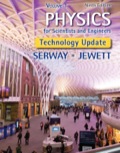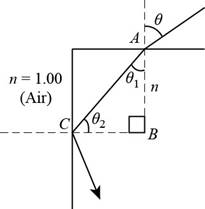
Concept explainers
(a)
The maximum angle of incidence for which the phenomena of total internal reflection occurs at the left vertical surface.
(a)
Answer to Problem 35.68AP
Explanation of Solution
Given Info: The light of wavelength
The refractive index of the polystyrene is

Figure (I)
For total internal reflection from the left vertical surface the angle of incidence for the vertical surface must be greater than the critical angle.
The formula to calculate the critical angle is,
Here,
Substitute
From equation (1) the value of the angle
From Figure (1) in triangle
Substitute
Thus the value of
Formula to calculate the value of
Here,
Substitute
As the angle
Thus any value of
Conclusion:
Therefore, total internal reflection will occur at the left vertical surface for any angle less than
(b)
The angle of incidence if the polystyrene slab is immersed in water.
(b)
Answer to Problem 35.68AP
Explanation of Solution
Explanation
Given info: The refractive index of water is
For the polystyrene slab surrounded in water the value of critical angle is,
Substitute
The value of
From figure (1) in triangle
Substitute
From Snell’s Law, calculate the value of the angle of incidence.

Here,
Substitute
Thus when the polystyrene slab is immersed in water the angle of incidence is
Conclusion:
Therefore, the total internal reflection will occur for angle of incidence
(c)
The angle of incidence for the phenomena of total internal reflection if the polystyrene slab is immersed in carbon disulphide.
(c)
Answer to Problem 35.68AP
Explanation of Solution
Explanation
Given info: The refractive index of carbon disulphide is
The phenomena of total internal reflection only takes place when the light ray is travelling form a higher refractive index material to a low refractive index material.
For the case where the polystyrene slab is immersed in the carbon disulphide the light ray at the interface of the left vertical wall will not undergo the total internal reflection as at the interface the light will be propagating form a lower refractive index material to a higher refractive material and for the phenomena of total internal reflection to occur the light must be travelling form higher refractive index material to a low refractive index material.
Hence, the phenomena of total internal reflection will not take place when the slab is immersed in carbon disulphide.
Conclusion:
Therefore, the phenomena of total internal reflection will not take place when the slab is immersed in carbon disulphide.
Want to see more full solutions like this?
Chapter 35 Solutions
EBK PHYSICS FOR SCIENTISTS AND ENGINEER
- Please see the attached image and answer the set of questions with proof.arrow_forwardHow, Please type the whole transcript correctly using comma and periods as needed. I have uploaded the picture of a video on YouTube. Thanks,arrow_forwardA spectra is a graph that has amplitude on the Y-axis and frequency on the X-axis. A harmonic spectra simply draws a vertical line at each frequency that a harmonic would be produced. The height of the line indicates the amplitude at which that harmonic would be produced. If the Fo of a sound is 125 Hz, please sketch a spectra (amplitude on the Y axis, frequency on the X axis) of the harmonic series up to the 4th harmonic. Include actual values on Y and X axis.arrow_forward
- Sketch a sign wave depicting 3 seconds of wave activity for a 5 Hz tone.arrow_forwardSketch a sine wave depicting 3 seconds of wave activity for a 5 Hz tone.arrow_forwardThe drawing shows two long, straight wires that are suspended from the ceiling. The mass per unit length of each wire is 0.050 kg/m. Each of the four strings suspending the wires has a length of 1.2 m. When the wires carry identical currents in opposite directions, the angle between the strings holding the two wires is 20°. (a) Draw the free-body diagram showing the forces that act on the right wire with respect to the x axis. Account for each of the strings separately. (b) What is the current in each wire? 1.2 m 20° I -20° 1.2 marrow_forward
- 2). How much energy is stored in the 50-μF capacitor when Va - V₁ = 22V? 25 µF b 25 µF 50 µFarrow_forward9). A series RC circuit has a time constant of 1.0 s. The battery has a voltage of 50 V and the maximum current just after closing the switch is 500 mA. The capacitor is initially uncharged. What is the charge on the capacitor 2.0 s after the switch is closed? R 50 V a. 0.43 C b. 0 66 C c. 0.86 C d. 0.99 C Carrow_forward1). Determine the equivalent capacitance of the combination shown when C = 12 pF. +11/20 2C C Carrow_forward
 Physics for Scientists and Engineers: Foundations...PhysicsISBN:9781133939146Author:Katz, Debora M.Publisher:Cengage Learning
Physics for Scientists and Engineers: Foundations...PhysicsISBN:9781133939146Author:Katz, Debora M.Publisher:Cengage Learning Physics for Scientists and EngineersPhysicsISBN:9781337553278Author:Raymond A. Serway, John W. JewettPublisher:Cengage Learning
Physics for Scientists and EngineersPhysicsISBN:9781337553278Author:Raymond A. Serway, John W. JewettPublisher:Cengage Learning Physics for Scientists and Engineers with Modern ...PhysicsISBN:9781337553292Author:Raymond A. Serway, John W. JewettPublisher:Cengage Learning
Physics for Scientists and Engineers with Modern ...PhysicsISBN:9781337553292Author:Raymond A. Serway, John W. JewettPublisher:Cengage Learning Principles of Physics: A Calculus-Based TextPhysicsISBN:9781133104261Author:Raymond A. Serway, John W. JewettPublisher:Cengage Learning
Principles of Physics: A Calculus-Based TextPhysicsISBN:9781133104261Author:Raymond A. Serway, John W. JewettPublisher:Cengage Learning College PhysicsPhysicsISBN:9781305952300Author:Raymond A. Serway, Chris VuillePublisher:Cengage Learning
College PhysicsPhysicsISBN:9781305952300Author:Raymond A. Serway, Chris VuillePublisher:Cengage Learning Physics for Scientists and Engineers, Technology ...PhysicsISBN:9781305116399Author:Raymond A. Serway, John W. JewettPublisher:Cengage Learning
Physics for Scientists and Engineers, Technology ...PhysicsISBN:9781305116399Author:Raymond A. Serway, John W. JewettPublisher:Cengage Learning





